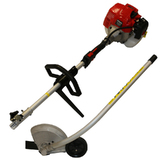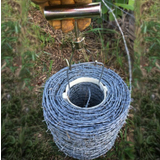
If you're new to using a chainsaw, you may wonder why the chain seems to get loose after a few hours of work. Is something wrong with your saw?
A loose chain is a hazard. It can come off the bar and fly towards the user, causing serious injury. Not to mention that cutting with a loose chain can damage your saw over time.
Chainsaw chain adjustment is a regular part of chainsaw operation and is simple to do. But every chainsaw is different, and how to adjust a Stihl chainsaw chain and how to adjust chain on a Husqvarna chainsaw, for example, may differ.
It's important to learn how to do it correctly and to recognize when some other issue might be at play.
Read on to learn how to adjust chainsaw chain tension to ensure you operate your chainsaw safely.
The Importance of Proper Chain Tension
So why is chain tension important? Your chainsaw was designed to operate with a certain tension on the chain. Having your chains at the correct tension ensures your chainsaw is working efficiently and safely.
A loose chain will cut less efficiently through the wood. You'll feel yourself having to push harder to finish the cut, and you'll be burning through your chainsaw's gas or batteries more quickly.
If the tension is too loose, the chain's drive links can become disengaged from the bar, creating a dangerous situation.
But it's also possible to overtighten your chain, which can lead to it breaking and flying off the bar.
It's important to learn how to gauge proper chain tension and what issues to look out for that might be causing your chain to come loose.
Reasons Chain Is Coming Loose
Aside from regular use, several things may affect the tension of your chainsaw chain.
1. Chain Is Not Properly Set
How can you tell if your chain is set correctly? First, take a look at the bottom edge of the guide bar. That's the edge closest to the ground when you're holding your chainsaw in the regular operating position.
Check that the drive links (those are the teeth facing towards the bar, not the cutting teeth) are sitting snug in the groove and not hanging down and visible. If you can see the drive links without pulling down on the chain, then the chain is too loose.
Next, use the "pull test" to see if the chain is too tight. Gently pull down on the chain, careful not to touch the sharp edges of the teeth. Pull down as far as you can without forcing it. You should be able to move the drive links away from the bar without pulling them completely from the bar groove.
2. Changes in Temperature
Temperature fluctuation can affect tension. As temperatures rise and fall, metal expands and shrinks, respectively.
When you're working in very hot or very cold conditions or running your saw nonstop for hours on end, the tension of your chain will be affected by these changes in temperature and will need to be adjusted more often.
3. Guide Bar or Chain Damage
Damage to the guide bar or to the chain itself may be affecting your chain tension beyond what comes from regular use. If left unaddressed, they could cause further damage to the saw or create a hazardous situation for the operator.
Look out for dents or bends in the guide of the bar. A bend in the bar can cause it to run less efficiently, while a dent can catch the chain, causing it to stretch over time or even break.
And look for any damage to the chain itself. For example, dull or chipped tooth blades again can cause the saw to be less efficient, which means you'll have to adjust it more often than if you had a sharpened chain.
4. Various Mechanical Issues
It's important to familiarize yourself with basic chainsaw maintenance to learn to spot when things aren't running right.
Making sure you're not running low on bar oil and keeping your air filters clear will keep your chain and machine from overheating.
How to Tighten Your Chainsaw Chain
First, you'll need to gather your tools.
Or really, one tool—a scrench. This is the screw/wrench combo tool that usually comes with your chainsaw and is the right size for the screw and bolts of your chainsaw.
If you can't find your scrench, you can use a screwdriver and wrench that fit your particular saw in a pinch. But for regular work in the field, it's best to order a replacement. You want to have the right tool with you since you'll be making these adjustments often while working on a project.
Next, loosen the bolt or bolts that secure the chainsaw bar. You don't need to take them entirely off; just enough to wiggle the bar around a bit.
Locate the chainsaw chain adjuster near the base of the bar. This will look like a screw. It is a pin that will lengthen or shorten your bar to adjust the tension.
Use the screwdriver to adjust the tension according to the "pull test" discussed earlier. When you're satisfied with your tension, retighten the bolts, and you're done!
Adjusting chainsaw chain tension is a straightforward process, though the exact procedure may vary between chainsaws.
The location of parts for a Stihl chainsaw chain adjustment might not be exactly the same as on a model by Husqvarna, for example. They may even vary between models of the same brand, especially looking at chainsaws for light home use vs. commercial logging operations.
If you're unsure of the location of all these parts, look up your particular model's manual before getting started.
Get Chainsaw Chain Adjustment Tools
Now that you know how to adjust chainsaw chain tension, you're ready to get back to work.
Missing the scrench or chainsaw chain adjustment screw for your chainsaw? Get chainsaw adjuster replacement parts only at Jono & Johno.
Whether you're adjusting Stihl chainsaw chain, Husquevarna, or any other major brands, we have replacement parts so your project can stay on track.
















